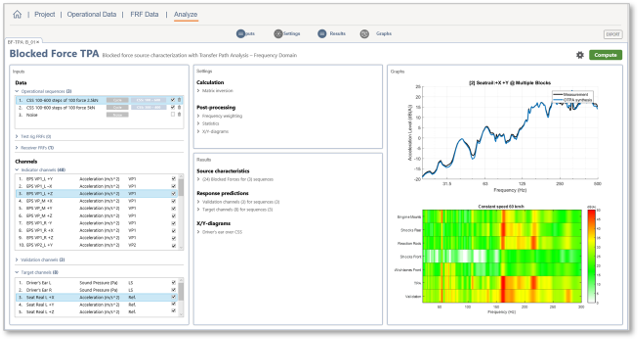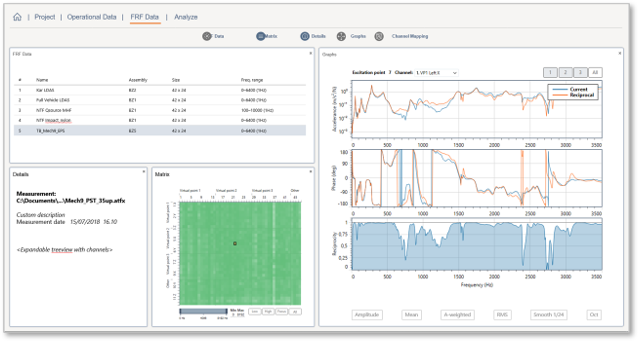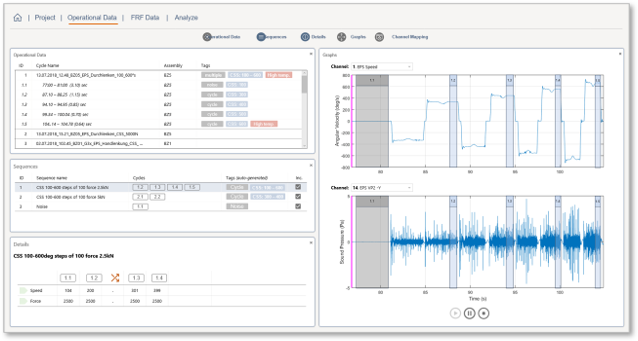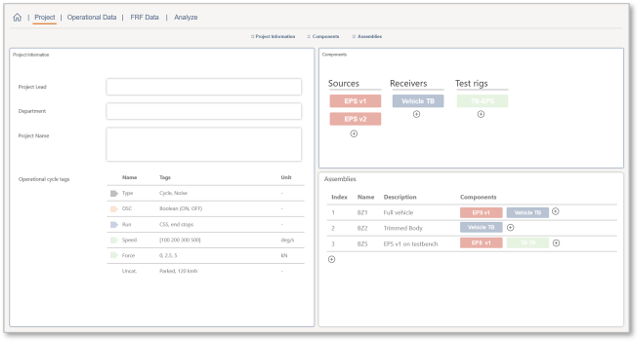Source Characterization
Describing active vibrations of a source system
Within the realm of transfer path analysis (TPA), the first step often involves characterizing the forces generated from an actively vibrating component – a process known as source characterization. The characterization can either be done using interface forces with the classical approach, or using blocked/equivalent forces with the component-based approach. Several methods are described here for determining these forces: classical TPA (interface forces) and component-based TPA (blocked forces/equivalent forces), which are explaned below and in this whitepaper on source characterization.
Classical TPA - Interface forces
Classical TPA is intended to identify transfer path contributions in existing products. The source excitation is represented by interface forces, which are a property of the assembly they are measured in. Their use for partial contribution analyses makes interface forces a valuable tool for determining which paths have the greatest contribution to the responses of interest.
- Direct measurement
The most straightforward technique to obtain the interface forces is from force transducers mounted directly between the active and the passive components. This approach requires that the transducers at the interface are very stiff in the frequency range of interest. The main drawback of this method is the inconvenience of mounting transducers between the active component and the receiving structure, making it impractical for most applications. - Mount stiffness method
In many automotive applications, the actively vibrating parts are attached to the vehicle body using resilient mounts in order to reduce vibration transmission. The mount stiffness method takes advantage of the fact that the amount of vibration on either side of the mount will not be the same. Using the mount stiffness approach, interface forces are calculated by multiplying the stiffness of the mount with the change in displacement across the mount (usually integrated from accelerometer data) during the operational test. One challenge of the mount stiffness method is getting an accurate characterization of the mount stiffness properties, although this is made possible with VP transform and inverse substructuring or decoupling techniques. - Matrix inverse method
The perhaps most popular method for determining interface forces is the matrix-inverse method. With the matrix inverse method, we use responses measured during operation multiplied with (inverted) FRFs to calculate forces. The operational measurements are made on the full assembly, and the FRF measurements are made on the assembly with the active component removed. The VP transformation makes it possible to get all six degrees of freedom (forces and moments) exactly at the interface. With a matrix inverse method, the success of the calculation is highly dependent on the choices for location and quantity of indicator sensors used in both operational and FRF testing. Typically the indicator sensors are placed in close proximity to the interfaces, with more responses than forces to improve the FRF matrix for inversion.
Component-based TPA – Blocked Forces / Equivalent Forces
Component-based TPA, on the other hand, is useful for simulating component vibration levels in new products. The source excitation is characterized by a set of equivalent forces that are an intrinsic property of the active component itself. More popularly, these forces are known as blocked forces, as they are the would-be forces (and moments!) when measured against a rigid boundary.
- Direct measurement
Perhaps the most straightforward technique to obtain blocked forces involves rigidly clamping the vibrating component so that its interface vibration is zero. By placing force transducers between the component and the test rig, we can directly measure the blocked forces. Some of the challenges encountered with this method include measurement of rotational moments, challenges designing a rigid test bench at higher frequencies, and limitations on where the force transducers can be easily mounted (e.g. before vs. after the bushings). - Free Velocity
The direct counterpart to the blocked-force method is the free-velocity method. In this case the component’s interfaces are left free, such that all vibrations are seen as ‘free displacements’ at the interface DoFs. From here on, equivalent forces can be calculated by inverting the FRFs measured at the free subsystem’s interfaces. In practice, it may be challenging to run the active component in operation in a free boundary condition. - In-Situ
At VIBES, we often use the in-situ technique to calculate blocked forces. Using the in-situ technique, the blocked forces can be calculated with the active component attached to anything: from the full vehicle to a softer test bench. Again a matrix inverse is used, where operational tests on the assembly are multiplied with (inverted) FRFs of the assembly. This technique is obviously quite similar to the matrix-inverse technique for obtaining interface forces, but has the advantage that the active component does not need to be dismounted – hence the name in-situ. Again, the success of the method is highly dependent on the choices for location and quantity of the indicator sensors used in the operational and FRF tests. Typically the indicator sensors are placed in close proximity to the interfaces, with more responses than forces to improve the FRF matrix for inversion. This method benefits significantly from use of the Virtual Point transformation, as it allows one to obtain FRFs exactly at the interfaces, even with the obstruction of the active component being mounted.
The smartest software solution
SOURCE
SOURCE is a dedicated software application for blocked force source characterization and component TPA. It generates high-quality and traceable blocked force and TPA calculations, an intuitive workflow and multi-leveled quality checks throughout the measurement.
Source Characterization (SC) and Transfer Path Analysis (TPA) are two highly popular topics in sound & vibration engineering, as they enable a modular NVH approach. Accurate characterization of active sources, typically by Blocked Forces, requires a clear and robust workflow with quality checks at each and every step.
SOURCE is the software application that enables you to do all of this. All variants of SC and TPA have been implemented in one intuitive application, designed from a clear vision towards high-quality and traceable source and TPA calculations.
Results and insights generated by SOURCE fit perfectly in current CAE simulations, allowing to solve critical NVH aspects in an early phase of product development.
Source characterization
Whitepaper
When you are interested in more profound information on this topic, please download our whitepaper on Transfer Path Analysis (TPA) – Source Characterization. In this whitepaper you’ll find theory and example cases on modular source descriptions using blocked forces. Enjoy reading it and don’t hesitate to contact us for more info.
Source characterization
Webinar
VIBES & Müller-BBM organized a successful webinar series in the spring of 2020 on component TPA (blocked forces). We showed the application of source characterization on an e-component, the validation in the vehicle and the importance of the right DoF on the interface.




